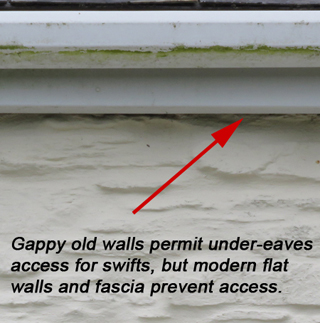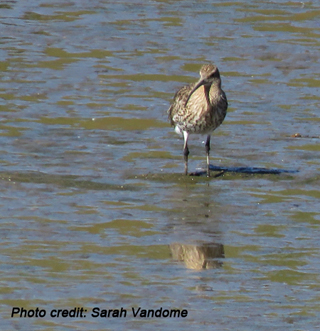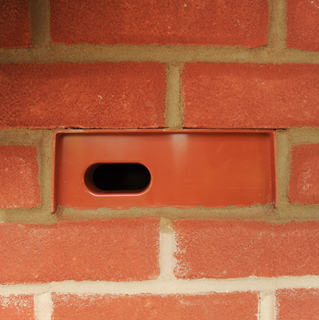 As we say goodbye once again to our migrating avian friends, Nick Coppin considers how life could be improved for them when they return to breed here next year.
As we say goodbye once again to our migrating avian friends, Nick Coppin considers how life could be improved for them when they return to breed here next year.
It’s always sad to realise, usually in mid-August, that the swifts have left us and returned to their winter homes in central and southern Africa. Along with swallows and martins, they are such a part of our summer skies, wheeling and screaming on warm evenings. I can remember years ago that the skies above the Roseland were full of swifts, swallows and house martins, scores of them in exuberant, noisy and dazzling aerobatic displays, hunting the abundant insects high up. But their numbers have been steadily declining and this year I only counted half a dozen at most above Portscatho. Will there be any at all next year?
The RSPB estimate that the British swift breeding population declined 42{c8c3b3d140ed11cb7662417ff7b2dc686ffa9c2daf0848ac14f76e68f36d0c20} between 1995 and 2013. The cause of this decline is likely to be a combination of loss of nesting sites due to building renovations, and reduction of flying insects due to pesticide use and intensification of agriculture. Their ability to nest in buildings, which replaced their usual nesting sites in crags, sea cliffs, caves and hollow trees, enabled swifts to colonise the increasing urban landscape.
 However, techniques and materials now used in modern and renovated buildings, whilst good for our comfort and the housing stock generally, are denying swifts and other birds access to nesting sites. We seal up buildings and use loft ventilation grilles, which creates swift-proof eaves, so our communities are no longer able to host species like swifts, to our detriment. There’s also a tendency to see wildlife sharing our environment as pests, with misplaced concerns over hygiene and damage to building structures.
However, techniques and materials now used in modern and renovated buildings, whilst good for our comfort and the housing stock generally, are denying swifts and other birds access to nesting sites. We seal up buildings and use loft ventilation grilles, which creates swift-proof eaves, so our communities are no longer able to host species like swifts, to our detriment. There’s also a tendency to see wildlife sharing our environment as pests, with misplaced concerns over hygiene and damage to building structures.
Many of our Roseland communities have seen much renovation and improvement of traditional housing as holiday homes. Whatever your views on this, one consequence is that we are inadvertently changing our environment, to the detriment of wildlife. And yet, this need not be the case. With some awareness of what we are losing, and a little thought, we can reverse this and accommodate species such as swifts living alongside us.
There are many techniques that architects, builders and homeowners can use to bring this about and there is plenty of excellent guidance on wildlife-friendly buildings and gardens (for example, the RSPB and the Royal Horticultural Society have information leaflets, available online). If you are planning to, or are already carrying out house renovations or improvements, consider including wildlife friendly techniques and materials and seek guidance on what you can do for birds such as swifts, swallows and house martins, as well as other species such as bats. Installing swift bricks (such as in this image, provided by the RSPB) and artificial nests in suitable places around your house before next spring, will ensure they are ready for the next nesting season when the swifts return.
The Wild Roseland Group (WRG) has a specific initiative under way on Homes for Wildlife, which will seek to make advice more widely available to Roseland residents and homeowners, and will undertake some special projects. The WRG has already been working with local schools to construct and install barn-owl boxes at suitable locations.
What to look out for this month in the Roseland
Where are all the birds? It’s a question often asked of birders by people concerned at the lack of visitors to their garden feeders. There is a straightforward and simple answer to this: moulting. Having spent much time, energy and effort producing and fledging young, all birds go through hormonal changes inducing moult to grow a complete new set of winter-ready plumage. Although flight feathers are usually replaced symmetrically, losing even one pair will impair a small bird’s flying efficiency, leaving it at greater risk of predation. So they hide away and forage furtively while staying safe.
 In large species – corvids and raptors, for example – gappy wings are an obvious indicator of moult. For them the moult is not usually so disabling as for smaller species, so daily life carries on as normal.
In large species – corvids and raptors, for example – gappy wings are an obvious indicator of moult. For them the moult is not usually so disabling as for smaller species, so daily life carries on as normal.
By October, most birds will have completed moult and be showing winter plumage. In some species such as waders and marine birds, the plumage is dramatically different between the seasons. Bright breeding colours are replaced by sombre ones, which aids in avoiding predation when in large groups. Look out for returning marine birds around our coasts and estuarine areas – the haunting cries of curlew, redshank and greenshank are already audible as they forage in the mud at low tide.
Upcoming Events
Inspirational Photography Required!
 Wild Roseland will be organising a photographic exhibition as part of the Roseland Festival in the spring of 2017. This will provide a challenge to all who enjoy photography to produce creative and interesting images of aspects of the natural environment of the Roseland. We will be advertising the themes for the exhibition in due course. Do let us know if you want to be involved in submitting images or helping in any other way with staging the exhibition. In the meantime, be on the lookout for great images that will help us all discover the natural treasures of the Roseland. Makes sure you take images at high resolution as the chosen images will be enlarged for the exhibition [Colin Hastings].
Wild Roseland will be organising a photographic exhibition as part of the Roseland Festival in the spring of 2017. This will provide a challenge to all who enjoy photography to produce creative and interesting images of aspects of the natural environment of the Roseland. We will be advertising the themes for the exhibition in due course. Do let us know if you want to be involved in submitting images or helping in any other way with staging the exhibition. In the meantime, be on the lookout for great images that will help us all discover the natural treasures of the Roseland. Makes sure you take images at high resolution as the chosen images will be enlarged for the exhibition [Colin Hastings].
Cirl Bunting Reintroduction Project News
The territory count for 2016 continues to rise. Currently at 65, there is still an increasingly diminishing potential to add one or two more. Extrapolating from last year’s more intensively collected data would still suggest that 2016 will show a population increase on last year. We’ll stop looking for more territories by mid September. The autumn monitoring will get underway in October, when we hope to start counting how many adults are around to enter the cold season.
A scientific paper on the project was published recently in the scientific journal British Birds (July issue). This paper details the development of the project work, from its initial planning through to the adaptive management required to ensure that it was ultimately successful. Subscribers only may view the complete article but a brief summary can be seen here. I also have one printed copy for people to view [Sarah Vandome].
References and links
RSPB (2016) Help Us Help Swifts. Online article. Available from:
http://www.rspb.org.uk/discoverandenjoynature/discoverandlearn/swifts/index.aspx
RSPB (2016) Building New Homes for Swifts and Communities. Online article. Available from:
http://www.rspb.org.uk/media/releases/423714-building-new-homes-for-swifts-and-communities
RSPB (2016) Swifts. Online article. Available from: https://www.rspb.org.uk/discoverandenjoynature/discoverandlearn/birdguide/name/s/swift/index.aspx
Edited by Sarah E Vandome
Contributors:
Colin Hastings, David Hall, Nick Coppin, Sarah Vandome
Enjoy more Roseland wildlife and landscapes – visit Sarah Vandome’s Heart of Roseland Facebook Photography page:
https://www.facebook.com/HeartOfRoseland?ref=hl


Wild Roseland is a group of volunteers who care passionately about looking after the nature and landscape of the Roseland peninsula in south Cornwall. Through a number of initiatives and projects, the aim is to inspire and enhance the conservation of this special place for all.



Is the viewpoint from the grassy car park area above Percuil?